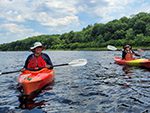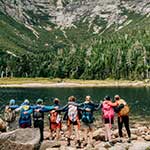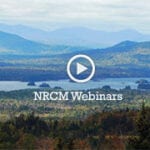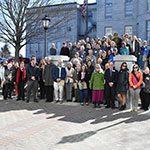NRCM works to protect Maine’s natural areas and wild, undeveloped character, particularly in the North Woods. We support responsible land development and sustainable forest practices that protect sensitive ecosystems and wildlife. We work for increased public ownership of Maine lands, so future generations will know the Maine we love today.
Protection of Maine’s natural, remote areas was one of the issues for which NRCM was founded in 1959. More than 60 years later, much progress has been made but major threats to Maine’s land and water resources continue.
With our coalition partners, NRCM has won many significant victories over the years, from helping establish the Allagash Wilderness Waterway to passage of legislation limiting irresponsible clear cuts. But the challenges of protecting Maine’s treasured wildlands and the wildlife that depend upon them have never been greater, nor the need more urgent.
We worked to establish a National Monument just east of Baxter State Park and continue our work to push for Land for Maine’s Future funding to acquire public lands, watchdog Maine’s public lands and the Allagash Wilderness Waterway, stop the ill-conceived East-West Highway from being built, weigh-in when harmful development is proposed in Maine’s North Woods, and ensure that any timber harvesting laws and policies are as protective as possible.
More than one-third of the state has changed ownership in the past 20 years. Corporations that have no stake in our local communities are buying up hundreds of thousands of acres. Slicing and dicing these natural areas can destroy the character of Maine’s North Woods forever.
This loss would affect not only the people of Maine but also our wildlife. The region is home to moose, bear, deer, and dozens of bird species—Boreal Chickadee, Spruce Grouse, Pine Grosbeak, Cape May Warbler, Yellow-bellied Flycatcher—for which the North Woods are the southernmost limit of their breeding range. Maine’s North Woods also provide many recreational opportunities for Maine people. Unchecked development threatens access to undeveloped, wild forests, lakes, and rivers for hiking, canoeing, camping, hunting and fishing.
While development pressures and the loss of public access continue to intensify, NRCM remains a voice for balancing economic development in Maine’s North Woods with conservation.
We invite you to learn more about our work to protect Maine’s North Woods and other natural areas, and to support our vital work for generations to come.

The East-West Highway
Gateway to opportunity or toll on the environment? by Edgar Allen Beem Downeast.com news story In March the Maine Legislature approved and in April Governor Paul LePage signed into law LD 1671, a measure appropriating three hundred thousand dollars for an investment grade feasibility study of whether it would be a good deal for a Read More

East-West Highway: Savior or Albatross?
Environmental concerns aside, whether the $2 billion project is economically feasible or not could depend on how consultants look at it. by Colin Woodard, staff writer Portland Press Herald news story Mainers are often described as being risk averse, conditioned by thin soils, frigid winters, Colonial-era Indian wars, and a century and a half of Read More

NRCM Statement on Conservation Easement on Plum Creek Land
NRCM is always pleased to see conservation easements in Maine’s North Woods. This easement prohibits further residential development and guarantees public access forever. NRCM remains concerned about the size and location of the Plum Creek development, particularly on Lily Bay. Plum Creek’s 2,000 units around beautiful Moosehead Lake, including three resorts, is the largest development Read More

Mainers Rally for Land for Maine’s Future
Bipartisan supporters say bond will spur economic growth and conserve natural resources Land Bond Coalition news release AUGUSTA — Heralding the economic benefit of conserving our state’s natural resources, Mainers including fishermen, sportsmen, conservationists, and lawmakers from both sides of the aisle called on the Legislature to replenish the Land for Maine’s Future (LMF) program Read More

Land For Maine’s Future Bond Will Face Plenty of Competition on Ballot
by Susan Sharon MPBN news story As bonds go, it’s a small one, just $5 million. But supporters of the bond to replenish the Land for Maine’s Future program said it faces an uphill battle even though polls show most voters overwhelmingly support the idea of preserving wildlife habitat and public access. That’s because the Read More

Maine Acquires 5,700 Acres around Seboeis Lake
Kevin Miller Bangor Daily News news story Maine officials on Monday announced the acquisition of more than 5,700 acres of land south of Millinocket in a deal that will protect an additional 2 miles of shoreline along Seboeis Lake while securing key snowmobile and ATV routes in the region. Several years in the making, the Read More
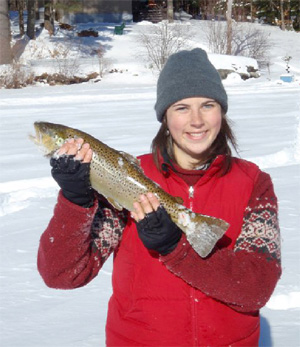
New Report Sheds Light on Disappointing Winter
Last winter, I wrote a blog post, Joys of a Maine winter, sharing my love for winter fishing in Maine. But this winter has been disappointing. With the warm December and January, and early spring (summer, really) temperatures, the ice fishing season was much abbreviated. I got out on the ice maybe only five times this Read More

Maine LURC Reform Proposal Wins Key Committee Endorsement
MPBN news story A controversial proposal to revamp the Land Use Regulation Commission has been unanimously approved by a legislative committee, virtually guaranteeing its passage by the full Legislature. Debate over the future of the agency responsible for zoning and planning in Maine’s vast unorganized territories has raged for more than a year. But one Read More
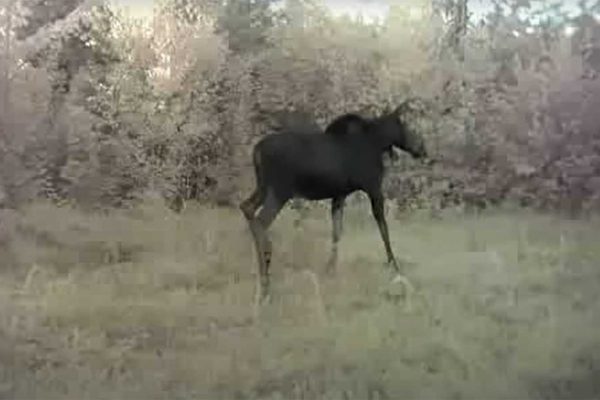
Wildlife Observation with Motion-Activated Cameras
Editor’s Note: NRCM member Bryan Wells sent along a video of a bobcat feeding on a frozen deer carcass. The video, captured using equipment he assembled and deployed himself, is one of many action pieces showing Maine’s fascinating wildlife doing what they do when they think no one is watching. We invited Bryan to share Read More
Banner photo: Moose near Baxter State Park, by Gerard Monteux
